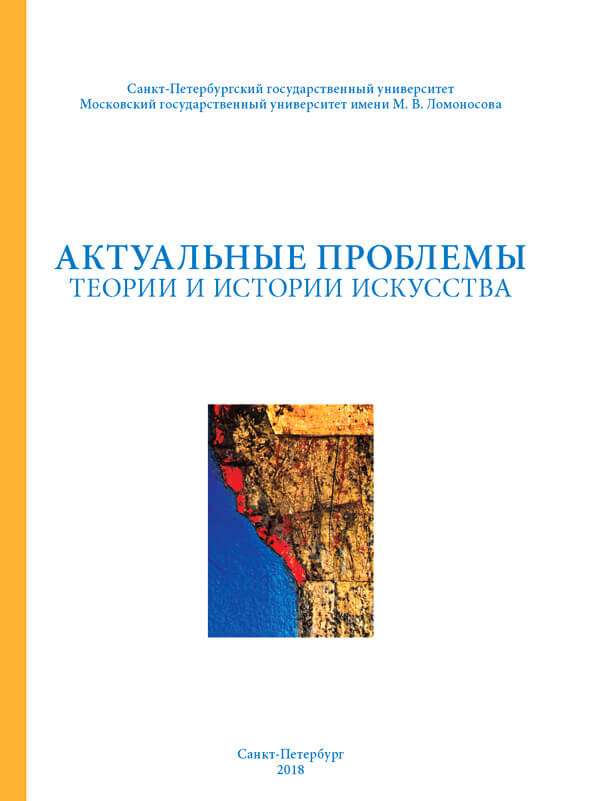European Porcelain of the 18th Century as an Artifact and an Art-Object or the Compotier’s Story
DOI:
https://doi.org/10.18688/aa188-7-62Keywords:
compotier, artifact, art-object, porcelainAbstract
European porcelain invented in the 18th century not only became an exceptional phenomenon in decorative and applied arts, but also was significant in historical and political sense. Mysteries, intrigues, and connections with alchemy that enveloped the beginnings of European porcelain production, gave grounds to the contemporaneous preconception that the products of newly founded manufactories were particular artifacts, and apart from their practical function possessed certain cryptic meaning.
Queenly porcelain sank into oblivion together with the century that had given birth to it. Around the 1820s, it was used to be known as “old” one, and “fell under scrutiny”, gradually turning from an artifact into an art object. Closer to the late 19th century, this transformation was completed and porcelain finally “occupied its special place in historical classifications”. Scrutinizing pieces of porcelain and their shapes and forms as art objects led to their higher artistic reappraisal. Since then it was only in fiction that porcelain has been presented as an artifact.
The classification system is in constant need of elaboration. In the history of porcelain, there are lots of examples when an item recently taken out of a kiln, in household turned to be different from what it had been initially designed for. This could be explained by either rapidly changing vogue, or by cuisine habits, or by national specificity. The denotations of objects changed in full correspondence with this.
All metamorphoses, from formal to philological, are possible to trace by taking a compotier as an example. This French word is used for shallow fruit bowls — various dishes that were part of dessert services. Special attention is to be paid to French porcelain, because, from the 1750s, France became the head “trendsetter” in this material, which was actually as new for this country as it was for others.
The basic regales of a dessert course were various candied stewed fruit taken from compote. Those were placed into compotiers made of various substances, but of the greatest variety were the shapes of porcelain items. Numerous studies proved that outstanding artists and sculptors worked to create seemingly ordinary things. The origins of inspiration were quite different: from a peasant wooden saucer to coquille Saint-Jacques.
In France, the proper idea of a dish for stewed candied fruit was clearly defined in the mid-18th century. In Russia, tableware was not strictly differentiated: quite various items, not only shallow fruit bowls, were called either “compotnik”, or “compotnitsa”, or designated with a loaned French word “compotier”.
Thus, such a prosaic thing like compote made scholars, who seek to comply with maximum historical authenticity and classification accuracy, seriously “work out the criteria for ambiguous notions”, turning to a wide range of research approaches and methods: from art historical analysis and studies in manufactories’ registries to the inventories of service still-rooms.
References
Bagdasarova I. (ed.). Iz serviznykh kladovykh. Ubranstvo russkogo imperatoskogo stola XVIII — nachala XX века (From the Dinner-Service Storerooms. Decorating the Russian Imperial Table in the 18th to Early 20th Centuries: Catalogue of Exhibition). Saint Petersburg, The State Hermitage Publ., 2016. 523 p. (in Russian).
Bellaigue de G. French Porcelain in the Collection of Her Majesty the Queen. 3 vols. London, Royal Collection Trust, 2009. 1312 p.
Biriukova N.; Kazakevich N. Sevrskii farfor XVIII veka (The Sevres Porcelain of the 18th Century. Catalogue of the Collection). Saint Petersburg, The State Hermitage Publ., 2005. 479 p. (in Russian).
Brunet M.; Préaud T. Sèvres. Des origines à nos jours. Fribourg, Office du livre Publ., 1978. 391 p. (in French).
Chevalier B. Les services de Dihl et Guérhard de l’Imperatrice Joséphine et du prince Eugène. Sèvres. Revue de la Sosiété des amis du Musée national de céramique, 1994, no. 3, pp. 25-29, 74-75 (in French).
Gilliers J. Le Cannameliste français, ou Nouvelle instruction pour ceux qui désirent d’apprendre l’office, rédigé en forme de dictionnaire, contenant les noms, les descriptions, les usages, les choix et les principes de tout ce qui se pratique dans l’office. Nancy, J.-B.-H. Leclerc Publ., 1768. 238 p. (in French).
Havard H. Dictionnaire de l’ameublement et de la décoration depuis le XIIIe siècle jusqu’à nos jours, vol. 1-4. Paris, Maison Quantin Publ., 1894. 5289 p. (in French).
Jijina N.; Mal’tseva S.; Staniukovich-Denisova E. Artifact. Art-Object. Argument: An Object in Fine Arts: Objectives, Methods, Results. Actual Problems of Theory and History of Art: Collection of articles, vol. 7. S.V. Maltseva; E. Iu. Staniukovich-Denisova; A. V. Zakharova (eds.). Saint Petersburg, St. Petersburg University Press Publ., 2017, pp. 15-20 (in Russian). Available at: http://dx.doi.org/10.18688/aa177-0-1 (accessed 27 December 2017).
Kazakevich N. Zapadnoevropeiskii farfor v Ermitage. Istoria sobrania ( Western European Porcelain in the Hermitage. The Story of Collection). Saint Petersburg, Nestor-Istoria Publ., 2003. 379 p. (in Russian).
Kudriavtseva Т. Russkii imperatorskii farfor (The Russian Imperial Porcelain). Saint Petersburg, Slavia Publ., 2003. 279 p. (in Russian).
Liakhova L. Sentimentalnoe Puteshestvie. Wedgwood v Rossii (A Sentimental Journey. Wedgwood in Russia). Catalogue of Exhibition. Saint Petersburg, The State Hermitage Publ., 2012. 206 p. (in Russian).
Massiallot F. Nouvelle Instruction pour les Confitures, les Liqueurs, et les Fruits, avec la manière de bien ordonner un Dessert, etc. Suite du Cuisinier Roïal et Bourgeois. Fr. Paris, Charles de Sercy Publ., 1698. 458 p. (in French).
Préaud T.; Albis A. d’ La porcelaine de Vincennes. Paris, Editions Adame Biro Publ., 1991. 240 p. (in French).
Savill R. The Wallace Collection. Catalogue of Sèvres Porcelain, vols. 1-3. London, The Wallace Collection Publ., 1988. 1272 p.


